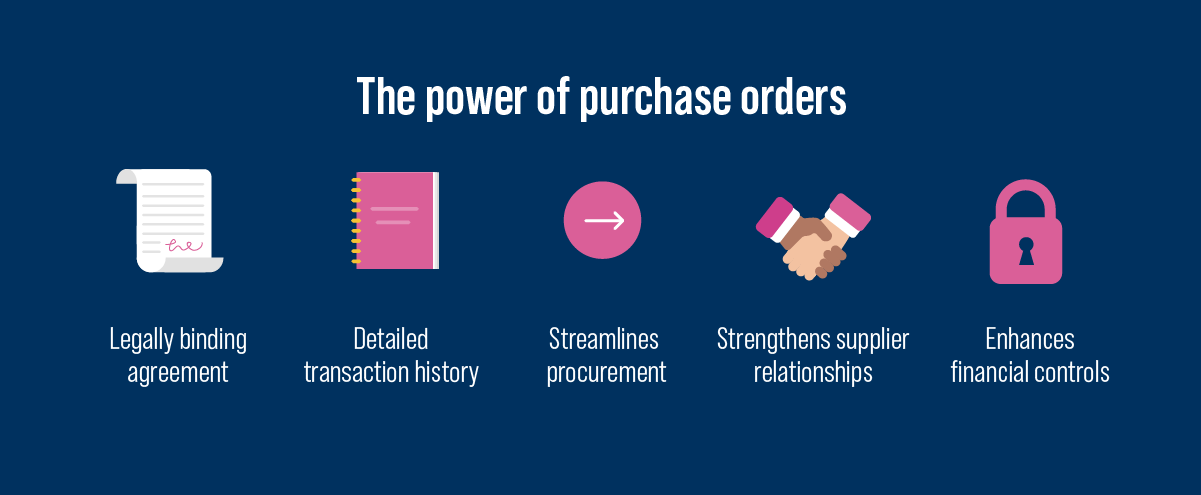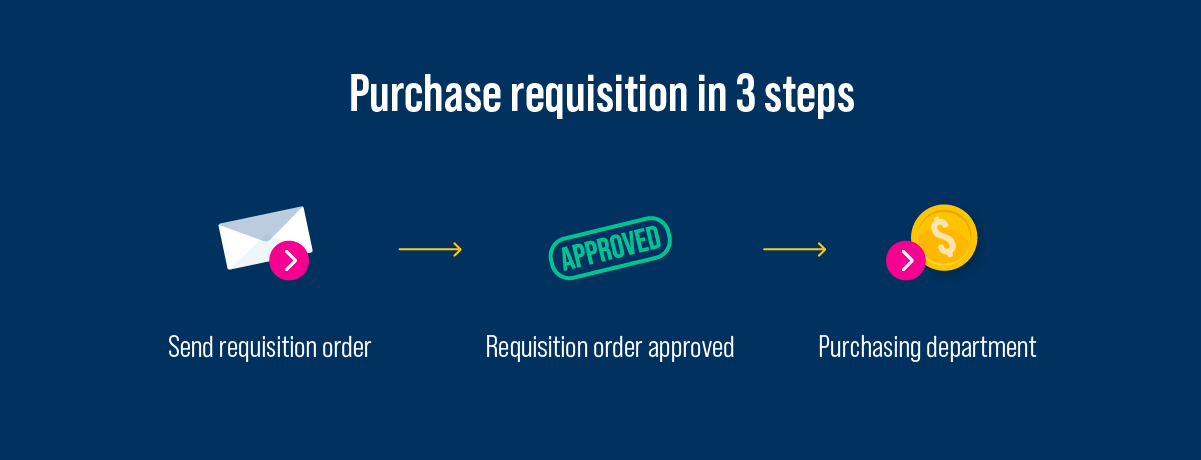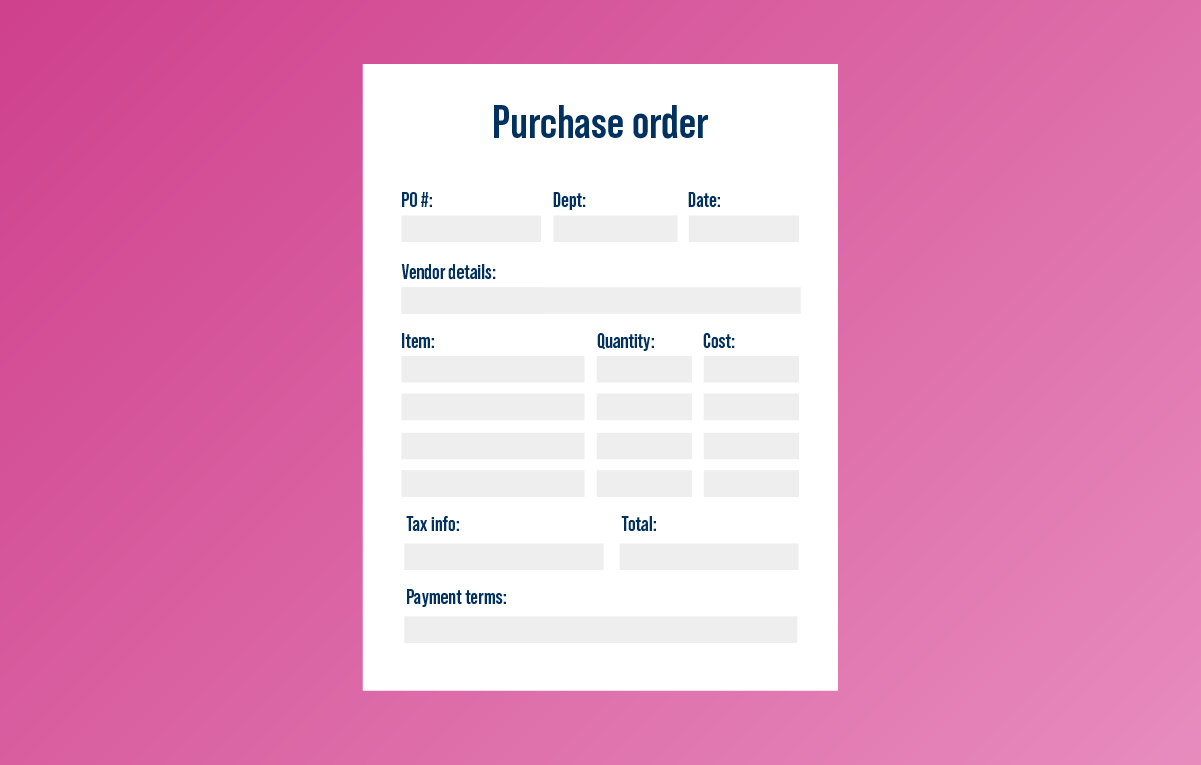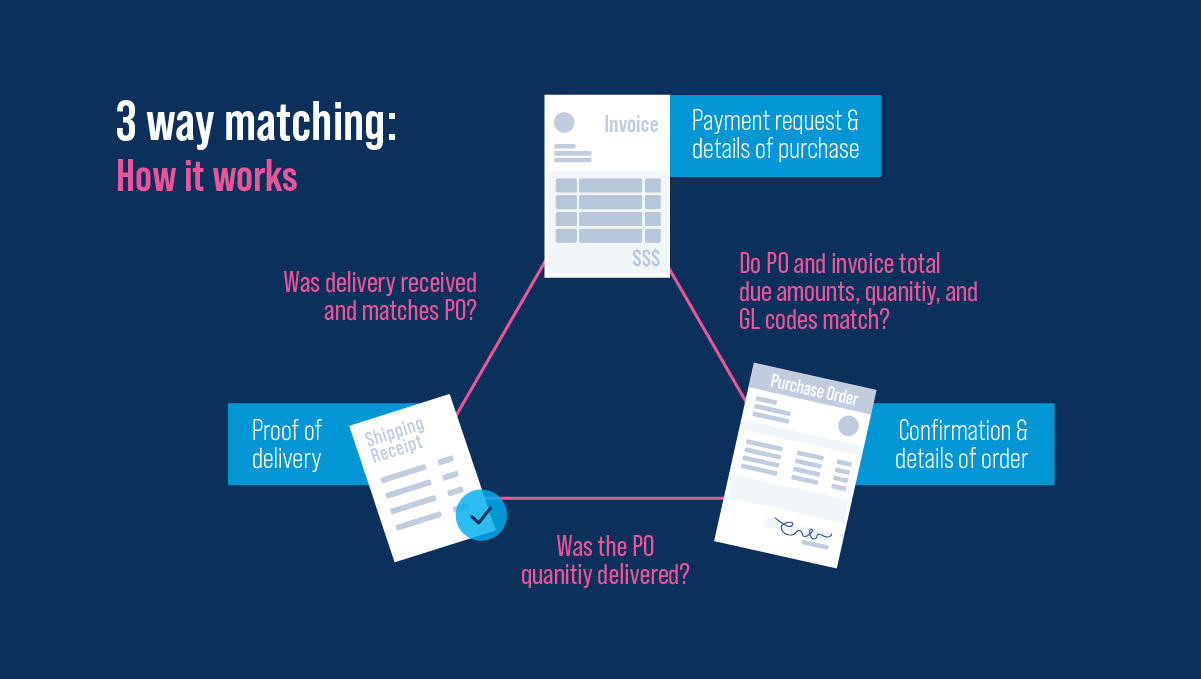How to improve the purchase order process: Best practices and tips

Manual procurement processes can hold your business back. Purchase order processing is a prime example. When it’s inefficient and inaccurate, it costs money, frustrates employees and vendors, and slows down procurement — all factors that can put the brakes on business growth.
Unfortunately, as anyone who has worked in procurement for more than a week can tell you, PO processes aren’t easy to fix. All too often, organizations approach the problem in one of three ways:
- Implement an end-to-end procurement automation solution without fixing the underlying problems and hope it works, or
- Patch over the underlying problems with point solutions and hope it works, or
- Keep things exactly as they are, and hope nothing blows up.
The result is almost always the same: a PO process that’s a mix of workarounds, unintegrated software solutions, and manual processes.
There’s a better way. How about taking a strategic approach to optimizing the stages by addressing bottlenecks, improving policies, and automating your PO process when and where it makes sense?
In this short guide, we explore tips, best practices, and technological solutions for streamlining workflows and removing bottlenecks at each step of the PO process. We’ll also share the story of a company that turned its broken PO process into a strategic asset for its business.
After reading, you’ll have a toolkit and a plan for improving PO processes and maximizing procurement efficiency. How does that sound?
We’ll start with a brief overview of PO management.
Why is the PO process so important?
As the central procurement document, the purchase order plays several roles. As a legally binding agreement between your business and a supplier, the PO documents the quantities and prices of the products and services you’re purchasing. It also records transaction details like taxes, payment terms, vendor information, and delivery details. Beyond its legal role, the PO is also the purchase record. It’s used to update financial records, confirm delivery of the goods and services ordered, and verify the accuracy of vendor invoices.

By ensuring that POs are error-free and accurately recorded, an effective PO process brings your business several benefits, including:
Effective spend and cash flow management
Purchase orders are a record of your company’s past and anticipated expenses. By ensuring POs are accurate and properly recorded, a solid purchase order process supports good budgeting and cash flow management. For example, by looking at planned purchase orders for the upcoming quarter, finance teams can anticipate short-term spending needs and ensure the business has cash on hand.
Efficient purchase order process flow
An efficient PO process lets your procurement and AP teams track and manage many purchases at once. It provides visibility and control over tasks such as shipping, inventory management, and invoice processing. For example, recording and organizing POs makes it easier to validate shipments. The receiver can easily look up the relevant PO and compare it to the shipping receipt.
Strengthen supplier relationships
Accurate and complete POs provide suppliers with clear ordering information, making it easier to fulfill orders and send accurate invoices. They also minimize vendor disputes by ensuring payment and delivery terms, discounts, guarantees, and order details are written down.
Improved financial controls
A well-organized PO process helps businesses maintain a complete P2P audit trail and enforce internal controls. For example, by establishing a separation of duties and a clear approval process, a company can reduce the risk of unauthorized or fraudulent purchases.
Let’s explore how you can tweak your existing PO process to realize these and other benefits.
Best practices for improving manual purchase order processes
We’ll break the PO process into 5 steps to keep things simple. Your process may be different, but the basic steps should be the same. They are:
- Purchase requisition: “We want to buy this product or service.”
- Supplier selection: “Which supplier should we buy it from?”
- Purchase order creation: “Dear supplier, here’s a list of things we want to buy from you.”
- Shipment receipt and verification: “Did our supplier ship us the things we ordered?”
- Invoice matching and payment: “Does the supplier’s invoice match what we ordered and what they shipped? Yes? Ok, let’s pay them.”
At each step, we’ll explore things you can do to improve efficiency, reduce errors, and remove bottlenecks and obstacles.
Step 1: Purchase requisition
The purchasing process begins with the purchase requisition — the document that sets out what products and services you want to buy. Purchase requisitions can take many forms, from a simple email saying “I want to buy a stapler” to complex multi-page documents. However, they all follow the same process: An employee completes a requisition for what they want to purchase and sends it for approval. After the purchase request is approved, the employee forwards it to purchasing to continue the process.

Manual, paper-based purchase requisition processes are slow and can be a significant source of purchasing errors. They also expose your company to fraud, as paper requisitions are easily manipulated. The problem gets worse if you don’t have a formal approval process. Requisitions can go to the wrong approver or get lost in transit, causing delays in the purchasing process.
How to improve the purchase requisition process
Here are a couple of things you can do to improve the purchase requisition process.
- Use standardized requisition templates: Get away from email and paper requisitions by switching to uniform templates. Templates reduce requisition processing time (the time between requisition creation and approval) by making requisitions easy to complete, minimizing confusion, and ensuring that approvers see the same requisition format every time.
- Set clear approval workflows: Another way to improve requisition processing time is to clarify approval workflows. Create an approval policy that specifies the appropriate approval levels and routing for purchase requisitions. For example, for better control of high-value purchases, you may require the department director and finance director’s approval of all requisitions over $100,000.
- Implement a digital requisition system: Purchase requisition software boosts efficiency by automating purchase requisition creation and approval routing, significantly reducing requisition processing time. It also digitally records and stores requisitions, which can increase the purchase order accuracy rate (the percentage of accurate invoices over time), especially when combined with PO automation software.
Step 2: Supplier selection
The purchasing department selects a supplier once the purchase requisition has been approved. If the product or service can be sourced from an existing supplier, the purchaser will contact that supplier for price and availability. If not, the purchasing department must find and onboard a new supplier.
After selecting a supplier, the purchasing department creates and issues a purchase order.
How to improve supplier selection
The short description of supplier management is “it’s complicated.” It’s even more complicated for companies trying to manage suppliers via tribal knowledge, spreadsheets, emails, and paper files. Inefficient supplier management slows down purchasing and frustrates vendors. Here are a few effective ways to get things better organized.
- Have an up-to-date approved vendor list: Keep and regularly update a list of approved vendors. Having a list makes it easier and faster to select vendors, and it helps prevent unauthorized purchases. Keep the list in a central location where requestors, purchasing staff, and approvers can find it.
- Keep supplier details up to date: At the same time, ensure your supplier details (address, contact information, tax details) and documentation (contracts, licenses) are up to date. This reduces sourcing time and ensures that PO details are accurate. It also ensures that suppliers are compliant with documentation policies. For example, keep an up-to-date record of your suppliers’ insurance policies to confirm they have insurance coverage before you purchase from them.
- Invest in a vendor management system: Maintaining vendor lists and records in Excel spreadsheets can be difficult. Vendor management software simplifies the process by automatically collecting, storing, and updating vendor lists and records. Solutions like Stampli Advanced Vendor Management also help strengthen vendor relationships through collaborative features like self-serve onboarding and centralized communications.
Step 3: Purchase order creation
When the purchasing department has selected a vendor and negotiated the price and terms for the purchase, they create a purchase order. The purchase order sets out the descriptions, quantities, and prices of the products or services being purchased. It also includes the PO number, vendor details, tax info, and payment terms. After creating the PO, the purchasing department sends it to the vendor, who completes the order.

How to improve the purchase order creation process
Purchase orders should be accurate. They represent a legal contract between the buyer and seller, and any errors or omissions can lead to disputes, incorrect orders, or financial losses. Manual, paper-based purchase order processes are prone to errors, and purchasing departments must be diligent when completing POs to ensure accuracy. Manual PO processing is not easily scalable, which can be a barrier to growth. As the business grows and the volume and complexity of purchase orders increases, purchasing teams can become overwhelmed and fall behind, slowing the purchasing process.
Here are a few best practices for streamlining PO creation.
- Ensure accurate purchase requisitions: POs are usually based on the approved purchase requisition. If the requisition is complete and error-free, the purchasing department can create the PO faster, reducing PO cycle time (the time between when the PO is created and sent to the supplier).
- Maintain updated vendor information: Similarly, ensuring that vendor information is accurate and up-to-date speeds up PO creation.
- Automate PO creation: Purchase order software automatically creates POs and adds the purchase details and vendor information. It reduces PO cycle time and improves accuracy by eliminating manual processes. PO software solutions usually integrate with ERPs, AP automation, and other business systems to synchronize purchase orders and data across the organization.
Step 4. Shipment receipt and verification
After the supplier receives the PO, they process and ship the order to the buyer. The buyer’s receiver accepts the order, verifies its contents against the purchase order to ensure it’s complete, and adds the order to the inventory.
How to improve shipping receipt and verification
Receiving departments are busy. Relying on paper-based processes to receive and verify deliveries is slow, especially if the purchase order isn’t readily available when a shipment arrives. Things can get even more complicated when you add in partial shipments and multi-PO shipments. Here are some ways to improve the process.
- Set clear receiving procedures: Document the process for receiving and verifying incoming shipments. For example, to expedite processing, you may only require verification on deliveries over $50,000.
- Use a digital tracking system: Update shipping information and inventory systems by digitizing and entering shipping receipts. Using digital shipping receipts also facilitates easier three-way matching. (Step 5)
- Perform quality checks: Thoroughly inspect shipments for damage and ensure they meet the specifications in the PO. Regular quality checks help ensure a low supplier defect rate (percentage of shipments that arrive damaged or incomplete).
Step 5. Invoice matching and payment
After delivering the shipment, the supplier will send an invoice to the buyer’s accounts payable department. The invoice contains the shipment details, the amount owing, payment terms, and vendor information. The buyer’s AP clerk enters the invoice into the accounting system and then matches the invoice to the PO and shipping receipt to ensure the quantities, descriptions, and prices match what was ordered and delivered.
If all the details match, the AP clerk forwards the invoice for approval and payment. If they don’t match, the clerk holds the invoice and attempts to investigate and resolve the discrepancy.
How to improve invoice matching and payment
Like the other manual workflows in the PO process, manual invoice processing and matching are slow and error-prone. This is especially true of the three-way matching process.

The AP clerk must manually compare each line item on the invoice, PO, and shipping receipt to see if they match. If there are any mismatches, the clerk has to stop what they’re doing and investigate the discrepancy. Faced with growing invoice volumes and complexity, many AP departments struggle to provide accurate and timely three-way matching. As a result, companies often forgo matching on all but high-value invoices — potentially exposing the business to fraud and errors.
Here’s how you can improve the invoice matching and payment process.
- Automate invoice capture and entry: OCR and AI-powered invoice processing systems significantly increase invoice processing speed and accuracy, reducing invoice lifecycle times (the time between invoice receipt and payment). Invoice processing platforms also provide digital copies of invoices, facilitating faster and more accurate three-way matching.
- Set matching thresholds: Expedite the three-way matching process by setting exception thresholds. For example, you may set a 5% price matching threshold to automatically approve all invoices with prices within 5% of the price on the associated purchase order.
- Use integrated payment processing: Integrated payment processing systems unify payment methods onto a single platform. They integrate with ERPs, accounting systems, and AP software to automate payment processing, ensuring fast and accurate supplier payments.
- Use a PO matching solution: Most invoice processing systems use a rules-based approach to three-way matching. For example, they may automatically reject or approve invoices based on pre-set exception criteria. These systems can improve matching times. They will flag an exception if the item descriptions or other textual details don’t match exactly. For example, if the PO description says 30 “boxes of blue medium ballpoint pens” and the invoice says 30 “cases of ballpoint pens, blue, medium,” the system won’t know they are referring to the same product.
Stampli Cognitive AI™ for PO Matching accurately matches PO, invoice, and shipping receipt details 97% of the time. It understands context and nuance and can make human-like decisions about PO and invoice details — and truly automate the PO matching process.
Case study: Superior Masonry builds a concrete PO system
Based in Fort Mill, South Carolina, Superior Masonry is a growing construction company with a big problem. Reliant on manual paper-based PO and invoice systems, their P2P processes were struggling to keep up with their growth. The backlog made it difficult for Superior to calculate their job costs — crucial information needed for financial decisions about future projects. They needed a P2P solution that could streamline their paper processes, handle the unique aspects of the construction business, like cost codes and job costing, and integrate with their ERP, Sage Intacct Construction.
After considering several options, Superior implemented Stampli. The impact was immediate. Superior’s average invoice processing cycle dropped significantly from two weeks to a single day, a 93% reduction. Stampli’s AI-powered features, including Cognitive AI, played a central role. Matt Andersen, Superior’s CFO, describes how Billy the Bot, Stampli’s AI assistant, has transformed their P2P processes: “The AI matched at 100% on every line on each of the 22 invoices that came in that day. Even though five of those invoices were around three pages long, the AI still matched everything perfectly. It only took me 15 minutes to review those invoices, compared to the many days it would have taken my team and I to process them manually.”
Superior’s PO process has become more organized and transparent. The enhanced visibility into purchase order and invoice matching has enabled them to identify and address discrepancies, such as vendor overcharges and orders never received, saving them $10,000 monthly.
Take PO processing to the next level with Stampli
Ready to take your P2P process to the next level? This guide gave you the roadmap; now it’s time to take action. Stampli’s AI-powered solutions offer the tools and technology you need to optimize your P2P workflow and maximize efficiency.
Improving your P2P process requires a strategic approach that addresses bottlenecks, improves policies, and automates where it makes sense. By leveraging evolutionary solutions like Stampli’s AI Line-Level PO Matching and Cognitive AI for PO Matching, you can intelligently automate key aspects of your P2P process, freeing your team to focus on higher-value tasks and strategic initiatives.
Don’t just hope for a better P2P process – build one. Contact Stampli today to learn how our solutions can help you transform your PO process into a strategic asset for your business.